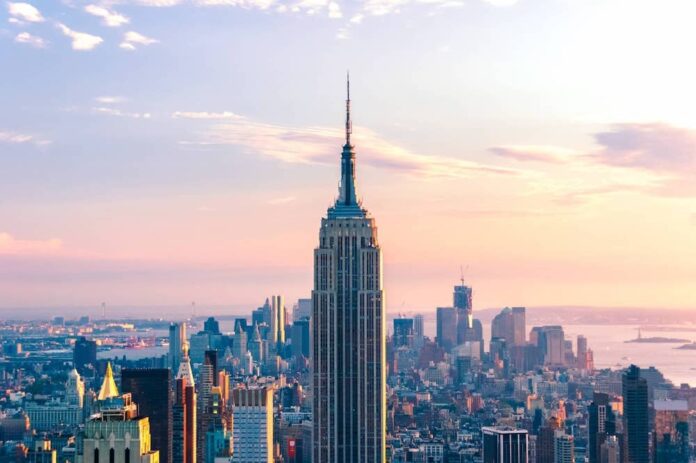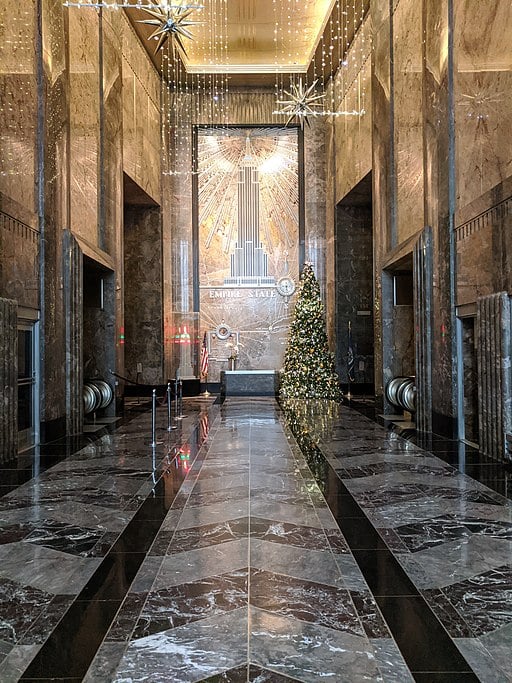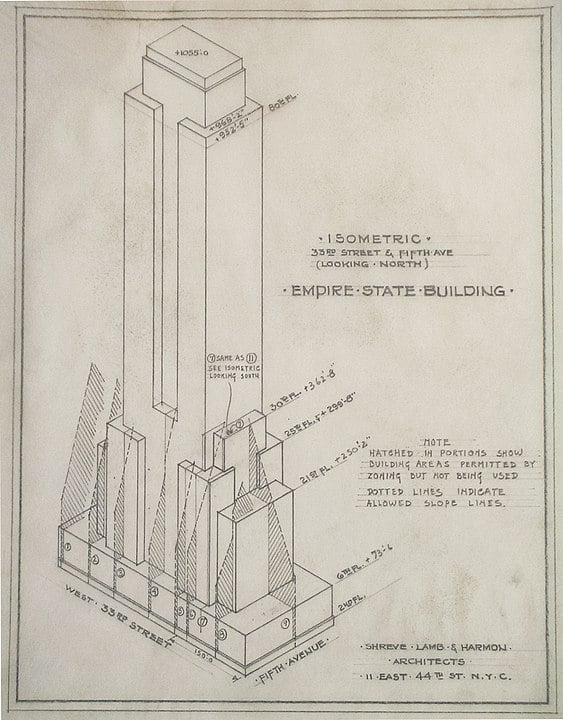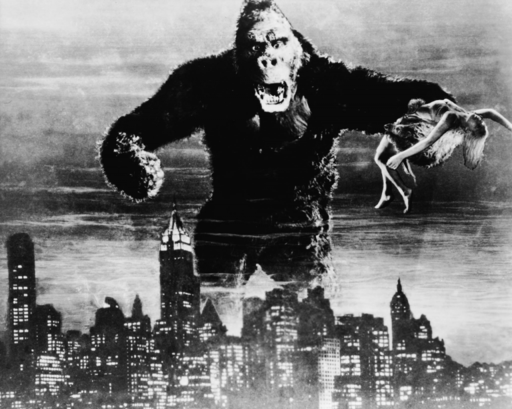“From the ruins, lonely and inexplicable as the sphinx, rose the Empire State Building.” – F. Scott Fitzgerald, My Lost City, Personal Essays 1920 – 40.
At 1,454 feet tall from foundation to antenna, the iconic 102-story building punctures the clouds, defines the New York City skyline, and towers over residents and buildings alike. Though only 91 years old, the Empire State Building is integral to the legacy and the history of Manhattan. The building has stood as a beacon of hope through the city’s darkest days, from the Great Depression to the September 11th attacks on the World Trade Center. It has served as a stage for television and film’s greatest moments, from Sleepless in Seattle to King Kong. It is a sight at which tourists marvel, and was even the site where Marvel comics were born. It is a tower with personality, a love for Taylor Swift, and allegedly a ghost or two. It is a building that is so much more than just a building.
So where did it all begin?
Who Built The Empire State Building? Breaking Ground
The story of the Empire State Building begins far before the structure itself. Even the land on which it was built is significant.
Located at 20 W. 34th Street, the Art-Deco masterpiece stands in what today is considered Midtown Manhattan. In the late 1700s, however, the neighborhood was quite different. Rather than a bustling metropolis, it was the idyllic farm of John and Mary Murray and is said to be the site where George Washington’s troops retreated to after the battle of Kips Bay during the Revolutionary War. The Murray family has had an extensive impact on New York City, from the naming of Murray Hill to the creation of the New York City Public School System (by way of John Murray Jr.’s Free School Society in the early 1800s) to being the owners of the land that would one day host the Empire State Building.
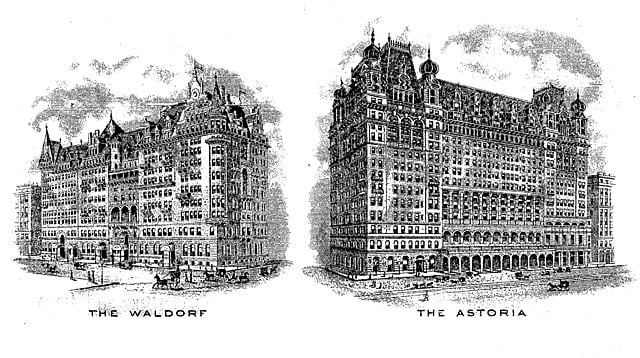
The Murray family sold the land to William Waldorf Astor in 1826; he would open the Waldorf Hotel at the site in 1893. In 1897, Waldorf’s cousin, John Jacob Astor IV, opened the Astoria Hotel next door. The two hotels soon consolidated to become the Waldorf-Astoria and would make headlines as the largest hotel in the world at the time. Despite its reputation as a “must-stay,” however, by the 1920s, much of New York’s elite had moved uptown, and so the hotel followed suit, relocating to 301 Park Avenue, where the Waldorf-Astoria still stands today. The original lot was sold to the Bethlehem Engineering Corporation in 1928, and the grand hotel was demolished to make room for something new.
That “something new” was initially going to be a 50-story office building, but the Bethlehem Engineering Corporation defaulted on a bank loan, and the land was re-sold before anything could be done. The new owners were the investment group “Empire State Inc.,” a cohort of elite New Yorkers joined by former New York Governor and 1928 Democratic Presidential Candidate Alfred E. Smith. The group purchased nearby land to ensure they had the two acres needed for their building’s base, and in August of 1929, Al Smith – who had been chosen to head up the corporation – announced the group’s ambitious plan: Empire State Inc. would build “an 80-story building on the site, to be taller than any other buildings in existence.”
How Old Is The Empire State Building
The boom years of the late 1920s saw an explosion of commercial buildings rise up in Manhattan as developers raced to get in on what was, at the time, a roaring and healthy economy. According to Robert Slayton’s Empire Statesman: The Rise and Redemption of Al Smith, “office space in New York had increased 51% from 1920 to 1930.” But for the elite real estate developers, it wasn’t enough to fill a skyscraper to capacity– their office building had to be the tallest one in the sky.
At the time that Empire State Inc. announced their building plans, two other structures posed massive competition – the Woolworth Building, clocking in at 792 feet, and the Chrysler Building, taking the crown at 1,046 high. For John Jacob Raskob, former Vice President of General Motors and the mastermind behind the Empire State Building, these were the buildings to beat, and nothing would stop his tower from reaching new heights. His structure would be a “monument to the future” and an “inspiration for the poor in a nation that reached for the sky with its feet on the ground.” At least, that’s what he pitched to investors in early October of 1929.
Unfortunately for Raskob, the future of the nation would turn bleak mere days later. On October 24th, a date otherwise known as “Black Thursday,” the stock market crashed, the banks failed, companies went belly-up, and the country would soon be plunged into the Great Depression. In the blink of an eye, the Roaring Twenties came to a screeching halt.
When Was The Empire State Building Built?
Interestingly, this did not deter the Empire State group. On March 17th, 1930, construction on the Empire State Building officially began. According to the Empire State Building’s website, under the direction of “architects Shreve, Lamb & Harmon Associates and builders Starrett Bros. & Eken, the framework rises 4 ½ stories per week.” Despite the crumbling economy, the race to build the tallest building in the world was charging full steam ahead. The project even managed to create jobs in a time when unemployment rates were rapidly rising; 3,439 workers were employed during the one year and 45 days it took to build.
A Steel Boned Masterpiece
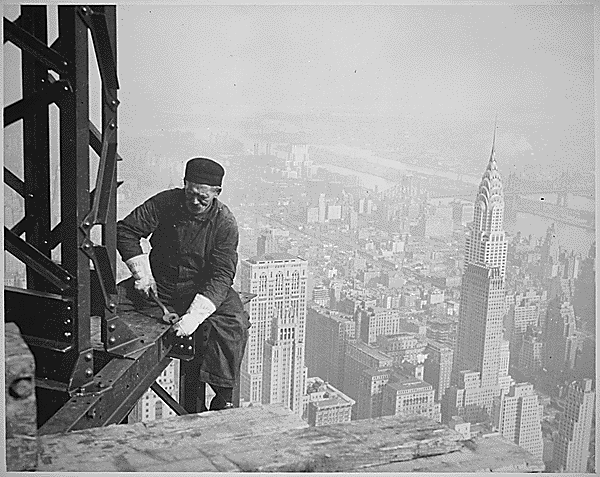
The Empire State Building was a modern marvel and notable for its innovations in structural engineering. At the time of its construction, it was thought impossible to build a tower taller than 100 stories. To achieve the unachievable, architects Shreve, Lamb and Harmon Associates elected to use a steel frame for the basic construction technique. The frame was built by ironworkers whom many dubbed “Daredevil Boys.” The workers were fearless, balancing on narrow beams hundreds of feet in the air, swinging on cables, often only with the support of a very basic harness.
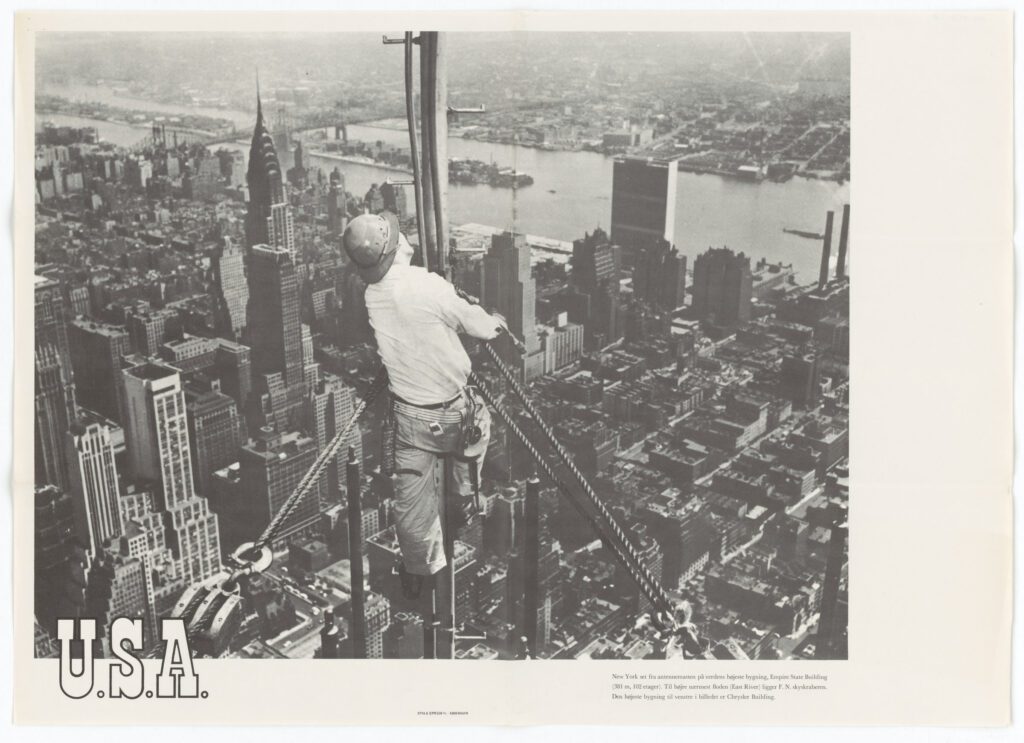
Official accounts report that five workers died during the construction of the building. Some sources offer contradictory (and higher) numbers. Regardless of the actual count, the deaths go to show that this work was dangerous; construction work in 1930 did not have the same safety guardrails and protections keeping workers alive today.
The building is considered an Art Deco masterpiece. Its strong steel bones are covered in limestone and granite with accents of aluminum. These materials, combined with recessed windows and a streamlined facade, are some of the defining markers of the Art Deco style. The building’s interior is just as notable; the lobby features a gold and aluminum mural on the ceiling, designed as an homage to the mechanical age. Above the entrance inside of the building, three medallions honor the craftsmen who built the tower, and the building trades used to complete the structure at the time of its construction.
Though the building itself is a guidepost of the Art Deco style, the unmistakable pencil shape is actually in part due to a 1916 zoning law. The ordinance established rules on a building’s mass as it grew, meaning that the taller a building was, the farther it had to be set back from its lot line. The result was a style known as the “setback-and-tower style,” which both the Empire State Building and the Chrysler Building are famous for.
The Empire State Building’s famous spire, too, has an interesting origin. One of Al Smith’s initial plans for the building was to build a “mooring mast” for dirigibles (airships) to dock. The idea was that passengers would exit the airship “down a gangplank, and a mere seven minutes later could be on the street.” This plan never came to fruition due to its impracticability, as gusty winds made docking impossible. However, the mast remained, serving as a reminder of what could have been and giving the Empire State Building its impressive and (at the time) record-breaking height.
On May 1st, 1931, the Empire State Building officially opened. President Herbert Hoover pressed a button from his office in the White House, and the lights to the building turned on. Al Smith’s grandchildren cut a ribbon in the building lobby, invited guests attended a dedication ceremony on the observation deck, onlookers gawked from the street. For both New York and the country as a whole, it was a day of celebration in a period of despair.
Many saw the construction and completion of the Empire State Building as a sign of hope for the beleaguered city, which American financier Bernard Baruch called “the symbolic capital of the Depression.” To build a 102-story building was an engineering feat in and of itself; to do so in the middle of the worst economic crisis in the country’s history was unfathomable.
Empty Chairs in Empty Offices
From the day it opened, the observation deck on the 86th floor of the Empire State Building brought in tourists eager to view the city from the sky. Retailers, too, were eager to secure a spot in New York City’s tallest building from the get-go. Despite the economic hardships of the Great Depression, only 12 of the 224 storefronts were unoccupied when the Empire State Building opened in 1931.
Unfortunately, office spaces – the bulk of the building’s space and income – were harder to fill. Only 23% of the office space in its first year was rented. The majority of the tenants were friends, family, or business associates of Raskob, Smith, and other members of the Empire State group. Even Al Smith’s dentist moved his offices to the building; he would stay there for many years to come. Add in some garment makers and the offices of the New York World’s Fair, and that makes up the bulk of the tenants in the early years.
86 nearly unoccupied floors of office space is not a good look for a brand-new building. To give the appearance of vacancy, the lights were continuously left on, even in the unrented spaces. Unfortunately, the ruse wasn’t enough to convince onlookers of a bustling building – New Yorkers soon dubbed it the “Empty State Building.”
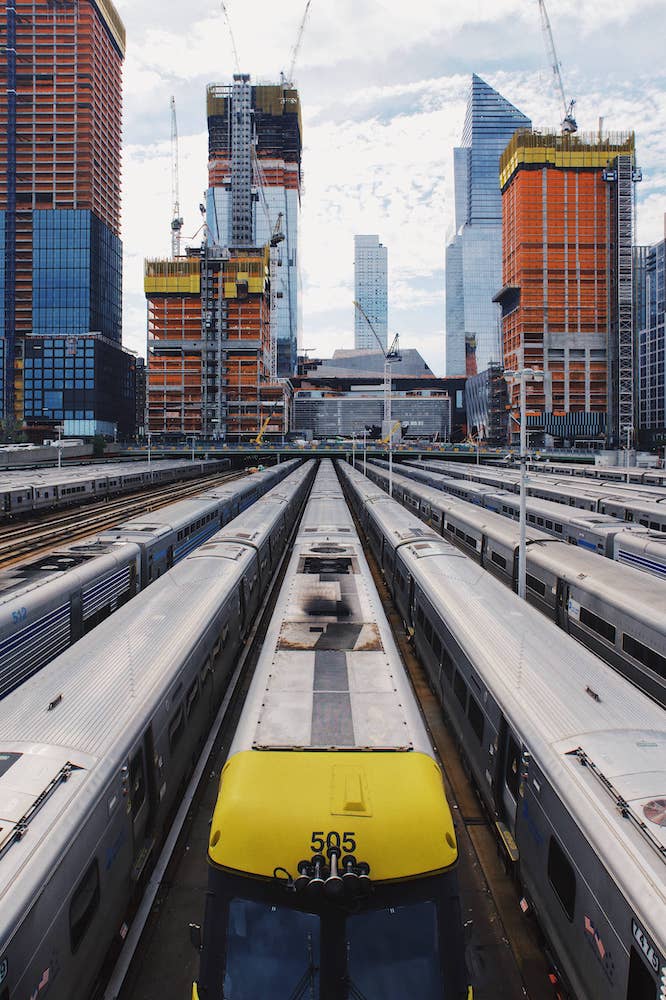
Much of the Empire State Building’s early occupancy issues were due to the economic conditions and a slow market. Interestingly, the pandemic years saw a similar conundrum.
Pre-2020, office space in New York City was at a premium, and developers couldn’t build fast enough. The ambitious $25 billion Hudson Yards project, aimed at revitalizing the area between Chelsea and Hell’s Kitchen, rolled out “Phase 1” in March 2019, which included a hotel, retail spaces, and ample office space. One year later, the COVID-19 pandemic sent workers home and permanently changed how employees interact with the workplace. In May 2020, the Financial Times called the development a “ghost town.” The vision of a bustling mini-metropolis within Manhattan faded as Hudson Yards struggled to fill its offices (and retain retailers designed to serve commuters). Though employees have trickled back to the office and a semblance of commuter culture has returned, as of September 2022, Hudson Yards still sat at a 37% vacancy rate.
The Empire State Building, too, was affected by the pandemic. Though many seem to be returning to the office, the adoption of the hybrid mode of work has impacted office rentals, retailers, and tourism alike. For example: in the second quarter of 2021, the 86th-floor observatory saw 162,000 visitors, 83% less than the one million tourists recorded during the second quarter of 2019. Though both tourism and return-to-office numbers have steadily risen since 2021 – the building reported 573,000 visitors in the second quarter of 2022 – it’s clear that the Empire State Building still has a ways to go before reaching pre-pandemic boom numbers.
The lesson? No matter how impressive the development, timing is everything. Whether it’s 1931 or 2020, macroeconomic conditions greatly affect the success of a building.
Empire State on the Up and Up
Despite a rocky first few years for office occupancy, the Empire State Building soon found its footing as both a cultural and economic icon. Though the owners did not make a profit on the building until the 1950s, by the 1940s, the building was 98% occupied. One notable tenant of the 1940s was Timely Comics, the comic book arm of American publisher Martin Goodman. It was in the Empire State Building that Goodman published the superhero stories which would eventually evolve into what is known as Marvel today.
The building steadily increased occupancy and gained notoriety throughout the 1930s and 1940s. However, there were two markers in the building’s early years that put it on the map as one of the most famous landmarks in New York City.
Height of the Empire State Building
From the moment it was completed in 1931, the Empire State Building claimed the title of “the tallest skyscraper in the world.” This title was held for 42 years, likely in part due to the onset of the Great Depression and the Second World War. In 1972, the World Trade Center’s North Tower surpassed the Empire State Building in height and took the title of the world’s tallest skyscraper. By the early 2000s, several other structures had surpassed both the Empire State Building and the World Trade Center for the title of tallest building in the world. After the September 11th attacks, the Empire State Building was once considered the tallest building in New York City; it kept this title until the erection of One World Trade in 2012.
That the Empire State Building was able to market itself as “the world’s tallest skyscraper” from 1931 – 1972 did a lot for its success. The title afforded both tenants and the building a certain cache. Who wouldn’t want to say that their office building is so big it has its own zip code?
KING KONG Filming and the Sale of the Empire State Building
On March 7th, 1933, the building received another legendary bit of marketing, this one by way of a giant gorilla-like beast on the loose from Skull Island. In the climax of the film, King Kong scales the Empire State Building, terrorizing New York City from 102 floors up, before falling to his death. It’s fitting that the film, which has been lauded for its groundbreaking use of special effects, used a building that was, at the time, a major achievement and pioneer in structural engineering.
Both King Kong and the “world’s tallest building” title cemented the Empire State Building’s place in the concrete jungle. To this day, it remains one of the most iconic markers of Manhattan.
Unfortunately, increased occupancy and building fame were not enough for Raskob, who listed it for sale in 1951. Purchased for $51 million, it was the highest price ever paid for a single structure at the time. The building would break its own record ten years later in 1961, when it was again sold at the new highest price paid for a single structure, this time for $65 million. Today the building is owned by the Empire State Realty Trust, a publicly traded real estate company.
No matter the owner, the legacy of the Empire State Building is not going anywhere. On May 19th, 1981 the building was awarded Landmark Status from the New York City Preservation Commission. It has become the gold standard when describing the height and length of other structures globally. And in 1994, it was named one of the Seven Wonders of the Modern World by the American Society of Civil Engineers.
Lore and Legends of the Empire State Building
With every icon comes a good amount of gossip, noteworthy people, and… ghosts. The Empire State Building is no different.
The Ghost of Evelyn Francis McHale
On May 1st, 1947 – exactly 16 years after the Empire State Building opened – 23-year-old Evelyn Francis McHale jumped to her death from the 86th Floor observatory. She landed on the roof of a United Nations limousine. Her death, which was captured by photography student Robert C. Wiles, was dubbed “The Most Beautiful Suicide” by Life Magazine. The photo of McHale was a sensation, even used by Andy Warhol in one of his prints.
Rumor has it that McHale’s ghost still haunts the 86th-floor observation deck. An account from Gawker reports: “tourists at the Empire State Building spot a beautiful woman, dressed in ‘40s-style clothing, face streaked with tears, on the observation deck. They watch in horror as she jumps to her death, only to find… She was already dead.”
The Seance of 1932
In the early days of (un)occupancy, the building’s desperate owners were willing to do anything in order to get their offices filled. That included a seance to contact the ghost of Thomas Edison. Led by a medium on the 82nd floor, the event was mainly a publicity stunt in hopes of drawing in more renters.
Death By Penny?
A famous urban myth about the Empire State Building is that “if one drops a penny off the top of the Empire State Building, it could kill someone or put a crater in the pavement.” In 2003, popular TV show Mythbusters put the theory to a test. Ultimately the myth was busted after the conclusion that a penny “cannot gain enough velocity to inflict lethal injury or put a crater into the pavement.” This did not, however, deter the Broadway musical Avenue Q from using the urban myth as a joke. In the musical, a character drops a penny off the side of the Empire State Building and inadvertently hits her rival, sending her into a coma!
Paging Walter Hobbs
The Empire State Building makes a major appearance in the 2003 Christmas movie Elf. Chaos is wrecked upon the office of naughty book publisher Walter Hobbs, played by the late James Caan, when Buddy the Elf visits his father at work. The building is Buddy’s guiding light as he traverses from the North Pole to New York City, following a shaker globe with the building at the center. Not surprising that a Christmas Elf took such a liking to the building; though the design was actually made to reflect a pencil, if one were to press all of the elevator buttons at once, it bears a striking resemblance to a Christmas tree.
TikTok and Taylor Swift
In recent years, the Empire State Building has developed an impressive presence on TikTok. The building’s account often goes viral for making fun of other skyscrapers in New York City, making videos with celebrities, and its apparent love of Taylor Swift. On the night before the release of her highly anticipated re-recorded Red album in November of 2021, the building turned its lights red, and the corresponding TikTok got over 7 million views.
Currently, the Empire State Building’s Tik Tok is run by two “Besties” who publish Gen Z-targeted content and personify the landmark to create major drama between nearby buildings and competing observatories such as The Edge.
@empirestatebldg WE RUN THIS CITY #empirestatebuilding #nyc #newyork #besties ♬ original sound – Random Memes and Stuff
Sleepless in Seattle
Lots of movies, TV shows, and novels have used the infamous observation deck as part of their story. Perhaps the most iconic, however, is Sleepless in Seattle. It’s the spot where star crossed lovers Annie Reed (Meg Ryan) and Sam Baldwin (Tom Hanks) finally meet to confess their feelings for each other on Valentines Day. Annie’s character (and the film’s writer, Norah Ephron) was inspired by the 1957 romance film An Affair to Remember.
Unfortunately, in the latter lovers Nickie Ferrante (Cary Grant) and Terry McKay (Deborah Kerr) do not get their happy ending at the top of the Empire State Building; Terry is struck by a car on her way to the building and never makes it to the observation deck.
Empire State Building Run-Up
Some go to the top of the Empire State Building for love; others head up a bit of exercise. Since 1978, NYCRUNS has held a foot race at the building called the “Empire State Building Run-Up.” The route spans from the bottom of the building to the 86 floor, with runners sprinting up 1,576 stairs. According to the Empire State Building’s website, it’s “the world’s first and most famous tower race, and the fastest runners have covered the 86 floors in about 10 minutes.” The 2022 Run-Up date was on October 6th at 8pm.
Who Owns The Empire State Building Today?
Since 2006, the ownership of the Empire State Building has been in the hands of Peter Malkin and his company Empire State Land Associates from Donald Trump and Hideki Yokoi for a sale of $57.5 million. Prior to that, Leona Helmsley also hand in the day to day operations
Visiting the Empire State Building
The Empire State Building is open 365 days a year, rain or shine. For observatory visits, tourists can head up early in the morning or after dark for nighttime views. The building offers group packages, specialty experiences, and even a VIP proposal package for the romantic types. For those looking for more than just a quick visit to the Empire State Building, both office and retail spaces are currently available for lease. The building is strictly commercial, so anyone hoping to call 20 W. 34th Street home will have to look elsewhere.
From the very soil it sits on to top of the record-breaking tower, the Empire State Building is an unmistakable part of the soul of New York City. The building has modernized with the city, and the longer it stands, the more stories it holds and visitors it welcomes. It is a place that has seen the city through the best and worst of times, and stands tall as a reminder of what New York City is: weird, wonderful, and very, very big.
Emily Bice is a New York based writer born in Michigan, but with family in Canada - so on paper she’s the nicest person you’ll ever meet. Emily graduated from The University of Michigan’s School of Music, Theatre, and Dance. She has worked as an olive oil farmer, press correspondent at Cannes, and in television, but her favorite job is writer. Playwriting credits include before the flood (The Chain Theatre, NYC), Purgatory (developmental workshop, Ann Arbor, MI), See You In A Few (one act, the thing theatre company, Zoom). Check out more of her work at emilyabice.com!


